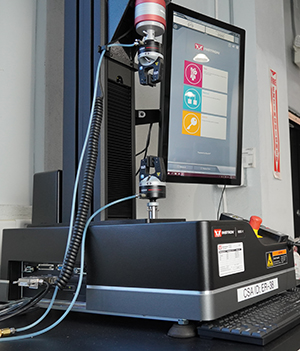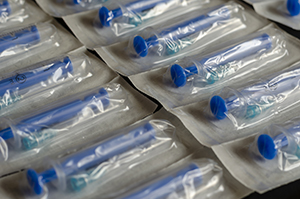Seal-strength testing can play a critical role when working to properly validate a package’s design and document its conformance to specifications. This is especially true when dealing with a product in a sealed pouch or a package system that incorporates a tray configuration with a sealed layer closure system.
 Seal-strength testing is designed to evaluate the strength of the seal to ensure a bond is formed and can endure the package system lifecycle. The data generated may prove useful in the validation process and can further be used as a quality control monitoring test for extended performance, and to confirm shelf-life stability (of the package not the product). While there are number of ASTM test methods specific to seal strength testing, two common and useful types include tensile strength testing and burst / creep testing.
Seal-strength testing is designed to evaluate the strength of the seal to ensure a bond is formed and can endure the package system lifecycle. The data generated may prove useful in the validation process and can further be used as a quality control monitoring test for extended performance, and to confirm shelf-life stability (of the package not the product). While there are number of ASTM test methods specific to seal strength testing, two common and useful types include tensile strength testing and burst / creep testing.
A good example of a tensile seal-strength testing method is ASTM F88 Package Strength Testing by Seal Peel Testing. This test is applicable to peelable medical package seals and a variety of heat-sealed packages. It can determine the force required by the end-user to open a peelable package as well as provide force data that can be used in validation and control of the sealing process. Understanding the significance of tensile seal strength is important when interpreting and reporting results. For example, the results may show a higher peak force on the initiation of the test, followed by a relatively constant force region during the peel stage and may be conclude with another increased force measurement. To correctly report results, it is critical to include the entire spectrum and not just the “high” number.
Another important reporting factor is sample preparation and test configuration. Samples may be tested in a supported or unsupported manner. Both approaches are acceptable, but the force results curves will not be equivalent. When using and unsupported method, the angle of peel is constantly varying from 90° to greater than 90°. In the supported method, a portion of the sample is restrained by a fixture to keep the angle of peel at 180°. The force result will vary depending on the support condition, so test results for different sample sets cannot be compared.
A good example of the Burst and Burst to Creep testing are referenced in ASTM F1140 Standard Test Method for Internal Pressurization Failure Resistance of Unrestrained Packages and F2054 Standard Test Method for Burst Testing of Flexible Package Seals Using Internal Air Pressurization Within Restraining Plates. In simple terms, these test methods require pressurizing the entire package and measuring the peak rupture pressure (burst test) or the time to failure at a constantly held pressure (creep). These tests provide a whole-package minimum seal strength and are equally applicable to peelable and nonpeelable seals. Inflation tests are applicable to most packages, such as pouches, header bags, lidded trays, flexible or rigid blisters, and laminated or rolled tubes. Although no universal mathematical relationship has been defined between tensile and inflation seal-strength tests, research on pouches shows a correlation between restrained- plate inflation testing and tensile testing in locating the minimum seal-strength area.
In a burst test, a package is inflated at a uniform pressure and flow rate until the seal separates at its weakest point. The burst test is a peak inflation pressure test with its variable being the back pressure inside the package at the instant of seal rupture. Control of inflation rate is important in a burst test to ensure consistent conditions. Material porosity determines inflation rate. Because air escapes through the walls of a porous package during inflation, the flow rate must be increased to compensate for that loss and create back pressure in the porous package. The burst test does not require extensive sample preparation. However, resultant burst pressures vary according to package characteristics. For example, the seal itself is a factor; peelable seals will part under a lower pressure than nonpeelable seals. Package size will influence the results; burst values of a large package will be lower than those of a smaller package. Unrestrained packages may have material failures before seal failures. These issues are not a factor when testing a single-style package with consistent methodology.

When using a creep test, the whole package is inflated to a constant pressure (based upon the results of the burst test), held for a specified time and resulting in a pass or fail result. It checks for slow shear of the adhesive bond, similar to what hanging a dead weight on the seal would reveal. ASTM F1140 suggests beginning the test with a creep pressure that is about 80% of the burst value. Different seal adhesives, such as pressure-sensitive adhesives, may need a lower creep-test pressure to be effective. Inflation rate is not critical as long as the initial fill is not too fast to shock the seal or too slow to lengthen the test. Shortcomings of the creep test include the need to visually examine the seal at the end of the test to declare the amount of seal peel for process control and the lack of a variable statistic upon which to perform process control analysis.
To achieve sensitive, repeatable results from both burst and creep tests, testers must accommodate samples. Sealed packages need access probes to inflate them. Probes may require reinforcement to prevent material splitting at entry points. Open pouches (sealed on three sides) need to be sealed with a mechanical clamp to pressurize the three formed- pouch seals.
Inflation seal-strength testing of unrestrained packages (ASTM F1140) quickly and effectively evaluates a package’s seal strength. However, there are no specific standards for that strength, since seal-strength values are relative to package size, geometry, materials, and bonding agents, even though tests show consistent process data on packages tested under consistent, repeatable conditions. In addition, package geometry affects the interpretation of test results. For example, pouches with a long side seal will generally fail on the long seal, unless a heater failure has occurred on the shorter seal or chevron. Unsupported tray lid seals may fail at points relative to their geometry. Very flexible materials may deform with pressurization to an extent that makes seal testing difficult. To address such problems, it may be wise to use restraining plates.
Restrained package testing (ASTM F2054) is a refinement that has several advantages. It has been shown to define the minimum seal-strength area of pouches more consistently. It provides more-consistent loading on the package seal, and it correlates well with tensile seal-strength tests in defining the minimum seal-strength area. Package geometry affects internal pressure distribution on package surfaces and seals. For example, a pouch unrestrained in any axis exhibits circumferential hoop stress when internal pressure is applied. When the package is restrained, the load application is distributed directly on the seal area, and, because material stretching and deformation is minimized, the test forces are more uniformly applied. In addition, package restraint has a direct relationship to burst pressure: The wider the gap between restraining plates, the lower the average burst pressure, with unrestrained packages yielding the lowest burst pressure of all. Use of package restraints must be approached with caution; because of pressures exerted on the plates, extreme care must be taken that fixtures are designed to withstand the forces applied by the inflated package.
As noted, the ASTM provides a number of test methods that are valuable for seal evaluation. Defining the most applicable and optimal method can depend on a wide variety of factors to include package type and product, intended use, lifecycle stage of the system and most significant, what is the goal is the testing (quality control of existing systems or as part of the package development process). The CS Analytical Team brings a plethora of experience with these specific ASTM methods and seal integrity issues with a large variety of package types. When working to define a seal evaluation program for your product package systems, we can work with you to define the plan that will work the best.

